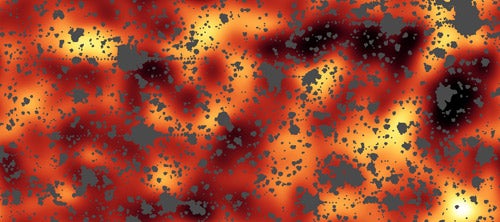The earliest stars in the universe were massive — at least 100 times our Sun’s mass — and burned their fuel quickly. They ended their lives just a few million years after their births, in huge explosions that left no direct way to detect them. However, ultraviolet light from these stars shifted to near-infrared in the universe’s expansion and contributes to a large portion of the cosmic infrared background (CIB) radiation.
NASA’s cosmic background explorer (COBE) detected a possible CIB signal in 1992. Scientists used NASA’s Spitzer Space Telescope to analyze ripples in the infrared sky, in much the same way the Wilkinson Microwave Anisotropy Probe (WMAP) measured the ripples in the microwave sky. The Spitzer group then subtracted out all known infrared sources — stars, galaxies, and dust — and was left with a background of infrared fluctuations.
The infrared signal Spitzer detected is statistically similar in each of four wavelengths — 3.6, 4.5, 5.8, and 8 micrometers — so this cannot be noise in one particular channel. In addition, the signal did not change between two observations taken 6 months apart, therefore, this signal is independent of the solar system’s zodiacal light (sunlight scattering off interplanetary dust in the elliptical plane, which changes direction depending on where Earth is during its path around the Sun).
Stars that lived roughly 100 million years after the Big Bang — when WMAP and computer simulations predict the first stars existed — would have had their light shifted to the wavelengths Spitzer imaged. “We think we are seeing the collective light from millions of the first objects to form in the universe,” says Alexander Kashlinsky, lead author of the November 3 Nature letter.
The scientists did not see point sources of light, but the diffuse signal is likely the combined light emitted by the first stars. NASA’s James Webb Space Telescope, expected to launch in 2013, will further analyze the CIB, dissecting it into individual objects.










